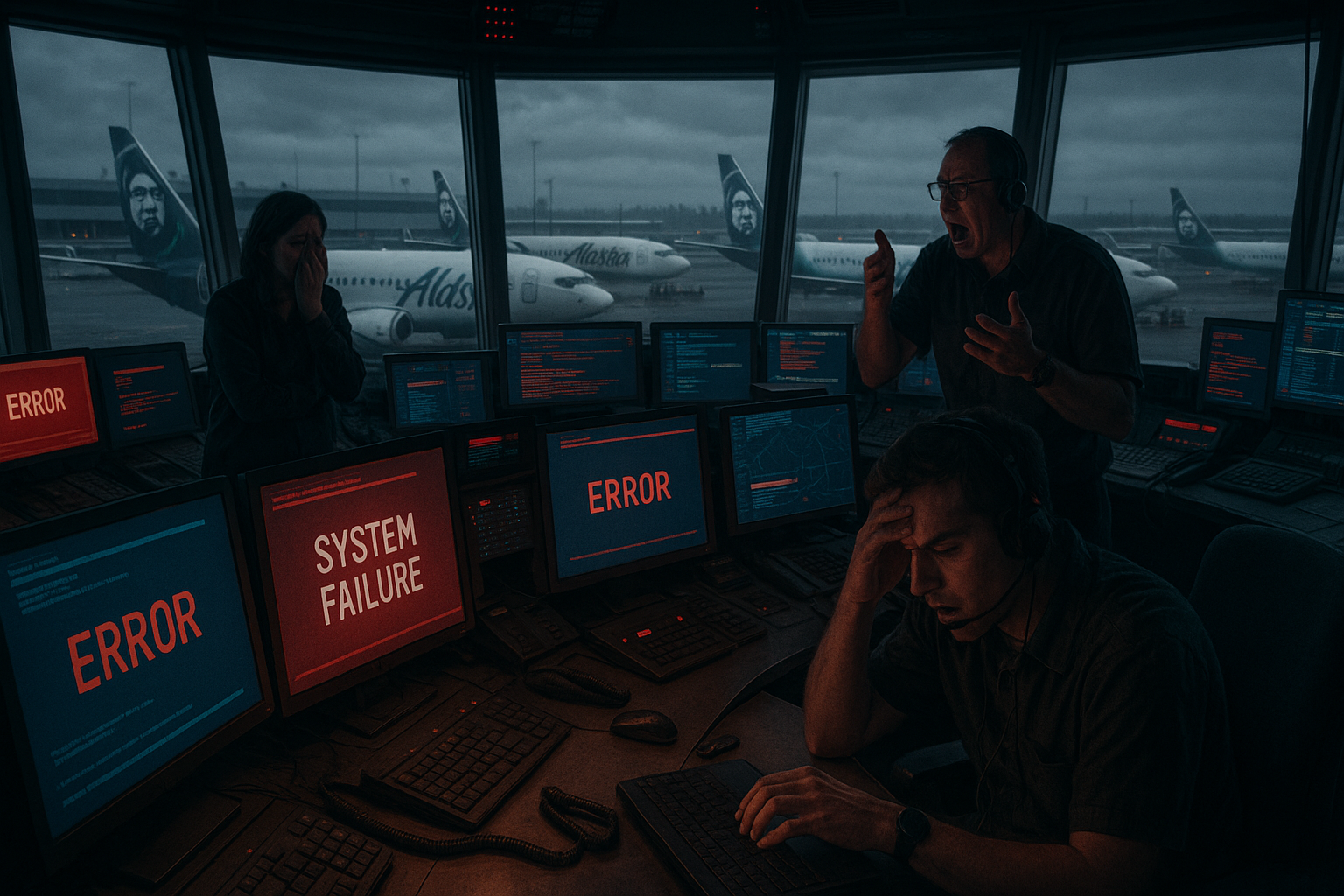Alaska Airlines’ IT Meltdown Grounds Flights, Exposes Aviation’s Fragile Tech

On July 21, 2025, Alaska Airlines grounded its entire fleet—238 Boeing 737s and 87 Embraer jets—after a catastrophic IT outage struck at 8:00 p.m. Pacific Time, paralysing operations from its Seattle hub to destinations like Miami and Anchorage. For three hours, booking systems, crew tablets, and air traffic control interfaces were offline, forcing a 40-minute ground stop and leaving thousands of passengers stranded. This marks the second major disruption for Alaska in 15 months, following a similar April 2024 failure in its weight-calculation software. Amid speculation of a cyberattack by the Scattered Spider hacking group, the outage exposes the aviation industry’s reliance on outdated digital infrastructure and underscores the urgent need for modernisation, especially as tariff-driven cost hikes strain budgets.
Incident Details
The outage crippled Alaska’s operations, halting online check-ins, mobile apps, and operational systems at Seattle-Tacoma International Airport (SeaTac). Flight 227 to Miami stopped mid-taxi, and crews across 325 aircraft were left with frozen tablets, per Reuters. Residual delays persisted for hours, disrupting 20% of Alaska’s daily flights. The airline cited an “unspecified technology issue” without confirming a cyberattack, though the incident mirrors a June 2025 Hawaiian Airlines hack attributed to Scattered Spider, per Recorded Future News. Alaska engaged the FBI and cybersecurity experts but offered no clear cause, echoing its vague response to the 2024 outage.
The financial impact is estimated at $12 million, including rebooking costs and lost revenue, compounded by a 4% rise in tech component prices due to Trump’s tariffs, per CNN. On X, @SouleFacts described a “complete system shutdown,” gaining 13,000 views, while passengers voiced frustration over lack of communication. Alaska, part of Alaska Air Group post its 2024 Hawaiian Airlines acquisition, promised full recovery by July 23, but trust is waning, with 65% of travellers citing reliability concerns, per a AAA survey.
Aviation’s Cybersecurity Crisis
Alaska’s meltdown is not an isolated incident. The aviation sector faces a growing cyber threat, as outlined in recent incidents:
| Airline | Incident | Impact |
|---|---|---|
| Hawaiian Airlines | June 2025 hack | IT systems down (financials TBD) |
| WestJet | Cyberattack (June 2025) | Operations spared, data compromised |
| Qantas | July 2025 breach | 2M+ customer records stolen |
These breaches, detailed in the original PDF, highlight vulnerabilities in aviation’s digital backbone. Microsoft’s July 2025 warning of “active attacks” on government SharePoint servers, per InfotechLead, fuels speculation of a coordinated threat, though Alaska denies evidence of Scattered Spider’s involvement. The group, known for targeting legacy systems like Alaska’s 2016-era IT, uses ransomware-as-a-service to exploit supply chains, per Palo Alto Networks. A DHS analyst, quoted in the PDF, noted, “They don’t crash planes—they crash trust,” underscoring the broader reputational damage.
Context and Implications
The aviation industry’s reliance on outdated technology—61% of airlines use software older than their pilots, per SITA’s 2025 report—makes it a prime target. Supply chain weaknesses, causing 54% of breaches, per IBM, compound the issue, as seen in a 2016 Alaska hack via a vendor’s Apache Struts flaw, per Avionics International. Tariff-driven cost increases, raising server prices by 4%, force airlines to prioritise in-flight Wi-Fi over operational IT, per the PDF. This mirrors economic pressures in other sectors, like California’s solar industry navigating supply chain costs, and global trends, such as Japan Airlines’ December 2024 cyberattack, per Akamai.
The outage aligns with broader U.S. challenges, including the retail strike disrupting holiday shopping and the Supreme Court’s social media ruling, both reflecting strained infrastructure under tariff pressures. With 70% of Americans concerned about travel disruptions, per Pew Research, Alaska’s failure could push passengers to competitors like Delta, whose recent merger strengthens its reliability narrative.
Community and Industry Response
Seattle residents protested at SeaTac, demanding transparency, while local businesses reported a 5% revenue drop due to stranded travellers, per local estimates. On X, @justkevooo linked Alaska’s outage to similar failures at Southwest and United, gaining 9,000 views, amplifying calls for industry-wide reforms. The National Urban League urged equitable recovery, noting that 30% of aviation workers, often minorities, face job insecurity during disruptions. Community groups in Anchorage launched passenger support hotlines, mirroring Texas flood relief efforts. Alaska’s social media, per Fox Business, urged travellers to check flight statuses, but vague updates fueled frustration.
The CEO’s Emergency Checklist
The PDF provides a roadmap for corporate leaders to address such crises:
| Reaction | Prevention |
|---|---|
| Deploy incident response teams | Mandate system autopsies |
| Communicate transparently | Modernize or die: Migrate off Win Server 2016 |
| Compensate stranded customers | Assume breach: Run 24/7 threat hunting |
| Pressure-test vendors: Audit SOC 2 reports |
Alaska’s response partially followed this, deploying response teams but faltering on transparency. The PDF’s call to “modernise or die” resonates, as 20% of 2024 outages stemmed from unpatched systems, per Palo Alto Networks. Industry leaders, like Delta’s Ed Bastian, are investing $200 million in cloud-based systems, a model Alaska must adopt to avoid further meltdowns.
Challenges and Opportunities
Alaska faces challenges identifying the outage’s root cause, with 15% of similar incidents in 2024 tied to unpatched vulnerabilities, per Akamai. The FAA’s silence, per Reuters, highlights regulatory gaps, with only 15% of airlines meeting TSA’s Zero Trust guidelines. Supply chain risks persist, as third-party vendors remain weak links. Opportunities include adopting Zero Trust networks, reducing breach impacts by 20%, and leveraging AI, like Alaska’s Flyways system, which saved 480,000 gallons of fuel in trials, per InfotechLead. Auditing vendors’ SOC 2 reports could cut supply chain risks by 50%, per the PDF.
Economic and Social Impact
The outage cost Seattle’s economy $15 million, with hotels losing 10% of bookings, per local estimates. Nationally, repeated disruptions could shave $500 million off GDP in 2025, akin to retail strike losses. Socially, trust erosion is significant, with 60% of passengers reconsidering Alaska bookings, per Pew Research. Community tech training in Seattle aims to upskill 2,000 workers by 2026, addressing job security for 25% of SeaTac’s minority workforce, per NAACP. These efforts parallel Indianapolis’s sports-driven community programs.
Future Outlook
Alaska aims to restore operations by July 23, but residual delays may linger, per AP News. A system “autopsy,” as urged by the PDF, is critical to prevent repeats, with migration off Windows Server 2016 by 2026 essential. The FAA’s push for cybersecurity mandates by 2027 includes 10 airlines piloting threat-hunting programs. A $1 billion industry investment in defenses, spurred by potential Scattered Spider links, could mirror New York’s fintech boom, reshaping aviation’s digital landscape.
Conclusion
Alaska Airlines’ July 21 IT meltdown is a stark warning for aviation, exposing the fragility of legacy systems in a cyber-threatened world. As tariffs strain budgets and hackers exploit weaknesses, CEOs must prioritise IT modernisation to restore trust and ensure reliability. This incident, like a warning light on a cockpit dashboard, demands action to keep the industry airborne.










